CHAPTER 2
TRIPOD-MOUNTED TOW/TOW 2
Regardless of the type of carrier the TOW weapon system is mounted on, at times it will be employed as a ground-mounted system. This may be due to tactical requirements, such as helicopter insertion for an antiarmor ambush, or it may be due to mechanical failure or battle damage to the carrier. The following information and procedures apply to all TOW units.
During combat or field training, TOW crews will sometimes be required to dismount the TOW system. Each TOW crew dismounts the TOW IAW
dismount procedures for the appropriate vehicle as outlined in this manual.
Section I. OPERATION PROCEDURES
Operation procedures for the TOW weapon system include performing a system checkout, conducting preventive maintenance checks and services (PMCS), selecting firing positions, and preparing TOW missiles for operation.
2-1. SYSTEM
CHECKOUT
The TOW weapon system is set up on the tripod to conduct a system checkout to ensure that the system is working properly before engaging targets. System checkout procedures are conducted before and after installation of an M220-series launcher on its organic carrier; daily, after the system is in use; or anytime the system has been in storage for one week. (See TM 9-1425-472-12 [M220A1] or TM 9-1425-450-12 [M220A2] for complete details.) After the system checkout procedures are completed, the weapon is mounted or installed on its organic carrier IAW the appropriate TM.
2-2. PREVENTIVE
MAINTENANCE CHECKS AND SERVICES
A preventive maintenance checks and services (PMCS) should be performed before, during, and after operation of the TOW weapon system. PMCS are performed daily if the system is in continuous use. (See TM 9-1425-472-12 [M220A1] or TM 9-1425-450-12
[M220A2] for complete details.)
2-3.
SELECTION OF FIRING POSITIONS
When the TOW is assembled for ground emplacement, the tripod must be level for effective operation of the weapon. If the tripod is not level, lateral (azimuth) movement of the traversing unit produces a change in the elevation angle of the launch tube; therefore, acquiring and tracking the target may be difficult. An unleveled tripod can cause an electronic control error during the final tracking operation (while the command-link wire is guiding the missile to its target). For ground emplacement, proper adjustment of the tripod legs compensates for uneven ground up to a slope of 30 degrees. Therefore, the firing position must not slope more than 30 degrees. When the tripod legs are properly positioned, the bubble in each level will be between the marks on the level indicator. The TOW is not fired from a position where the traversing unit has a lateral cant of more than 10 degrees. The ideal firing position is as level as possible. However, 2-1
FM 3-22.34
the missile can be fired from a position where the tripod is canted as much as 30 degrees directly downhill or uphill. (See Appendix C for more information on fighting positions.) After the site is selected and the weapon emplaced, the squad leader and gunner make a range card for the position. (For detailed information on making a range card, see Appendix D.)
2-4.
PREPARATION OF MISSILES
The TOW missile requires complete attention to detail when preparing it for firing missions. Missile identification, inspection, and correct handling procedures eliminate safety hazards to personnel and equipment. (See TM 9-1425-450-12 or TM 9-1425-472-12 for complete details.)
Section II. PERFORMANCE PROBLEMS AND
DESTRUCTION PROCEDURES
TOW crew members must recognize and overcome performance problems and limitations to survive in battle. Each unit develops and maintains an SOP for the proper destruction of ammunition and weapon systems.
2-5. MALFUNCTIONS
A malfunction is the failure of ammunition to function correctly when fired, or the unexpected functioning of explosive components during a test. Premature functioning during handling, maintenance, storage, transportation, or deployment constitutes a malfunction. Any abnormal functioning such as failure of the missile to leave the launch container on launch motor ignition also constitutes a malfunction. During operation of the TOW, a malfunction occurs if the missile fails to launch after the normal 1.5-second delay after the firing trigger has been pressed or if the missile fails to function properly in flight. Two major types of malfunctions are hangfire and misfire. In-flight malfunctions are classified as two basic types⎯duds and erratic flight. Defective missiles (either fired or encased) must be disposed of by an explosive ordnance disposal (EOD) team only.
NOTE:
When appropriate, weapon and vehicle TM checklists should be used when correcting malfunctions. (See TM 9-1425-450-12.)
a.
Hangfire. A hangfire is an unexpected delay in the functioning of a series of ammunition components. It may occur anywhere in the series of events, from pressing the firing trigger to launch motor ignition. After the trigger is pressed, the distinctive impulse of the squibs firing (to activate the missile batteries and gyro) and the gyro spin noise can be heard.
(1) If the missile fails to fire, alert the crew by announcing “Hangfire” and continue to track the target for one minute.
(2) If the missile fails to launch after one minute, close the trigger cover, lower the arming lever, place the elevation lock in the 8-degree down position, and place the azimuth lock in the locked position (do not lock the azimuth if it points the missile out of the left and right limits). Open the bridge clamp and remove the missile from the launch tube. Carry it to a dud pit or a safe distance from friendly troops.
2-2
FM 3-22.34
(3) Point the missile downrange at all times and notify EOD personnel.
WARNING
The encased missile will become hot to the touch
if the TOW thermal batteries, which generate
temperatures higher than 800 degrees F, are
activated. The encased missile will produce
smoke if the thermal beacon has been ignited.
b.
Misfire. A misfire (complete failure to fire) occurs if the launch motor fails to ignite after the firing trigger has been pressed. This type of failure may be caused by a faulty firing circuit, a failure of electrical power, poor electrical connections, short circuits, or faulty components in the ignition or propellant systems. When the missile fails to launch, the prefire functions are not heard and the condition is a misfire. The target is tracked for one minute and the trigger is pressed again.
(1) Alert the crew by announcing, “Misfire,” and check the battery (see notes 2
and 3). Then, check the MGS to ensure the coil cable connector is properly attached to connector J1. Turn the coil cable connector locknut clockwise until it is tight to make sure the coil cable connector is locked in place. Ensure the bridge clamp locking handle is properly seated. Lower the arming lever and check the backblast area to ensure no personnel are in danger; then, raise the arming lever. Press the trigger again.
(2) If the missile still fails to launch, continue tracking the target for one minute or at the gunner’s discretion (in combat). Close the trigger cover, lower the arming lever, place the elevation lock in the 8-degree down position, and place the azimuth lock in the locked position. Open the bridge clamp and remove the missile from the launch tube.
(3) Move the missile a safe distance away (minimum 100 meters) and place it on the ground, preferably in a dud pit. Point the missile downrange at all times and notify EOD
personnel.
c.
Dud. A dud is any missile that has been launched (fired from the launch tube) but failed to fly to the target or failed to detonate on target impact. The warhead of all duds must be considered to be armed, and therefore, extremely dangerous. The location of all duds will be noted and referred to EOD personnel for disposal.
d.
Erratic Flight. An erratic or uncontrolled missile flight may result due to any of the following conditions:
• Shorted or broken command-link wires.
• Defective missile wing or control surface.
• Defective rocket motor.
• Excessively high gunner tracking errors.
NOTES: 1. In a training situation, wait 30 minutes after announcing, “Hangfire”
before proceeding.
2. For the M220A1, (MGS self-test position 1) check for proper band reading. If out of band reading, replace the battery.
2-3
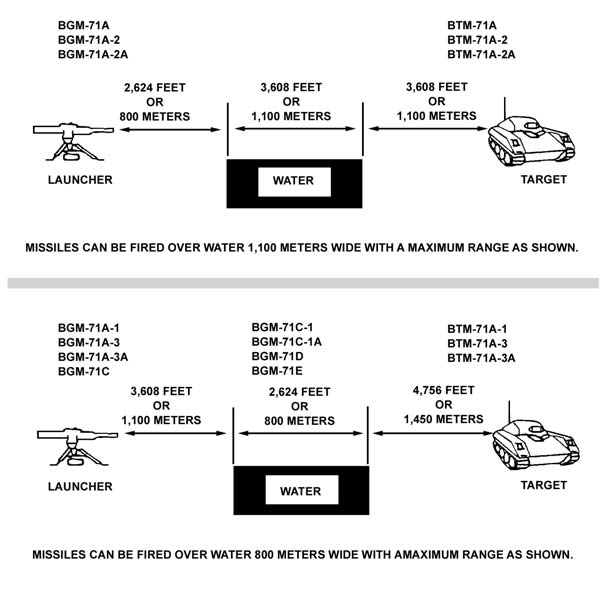
FM 3-22.34
3. For the M220A2, do MGS self-test for battery. If battery fails, replace the battery.
4. In a training situation, lower the arming lever, close trigger cover, place elevation lock in locked position, place azimuth lock in locked position, and wait 30 minutes.
5.
Report
all
misfires,
hangfires, and other missile malfunctions IAW
AR 75-1.
2-6. FIRING
LIMITATIONS
Some conditions may limit the firing and engagement capabilities of the TOW. The following information should be considered before engaging targets. (See TM 9-1425-450-12 for updated firing limitations.)
a.
Firing Over Water. Firing across bodies of water wider than 1,100 meters can reduce the range of the TOW. Signals being sent through the command-link wires are shorted out when a large amount of wire is submerged in water. Maximum and limited range firing over water varies according to missile type. If the range is less than 1,100
meters, the missile’s range is not affected. A TOW position should be as high above and as far back from the water as the tactical situation allows. The squad or section leader should analyze his sector as soon as the position is occupied to determine if water will affect the employment of the TOW.
(1) The various types of TOWs listed may be fired over water to a maximum range as shown in Figure 2-1 (TOW launcher and target at water surface level).
Figure 2-1. Maximum TOW missile range.
2-4
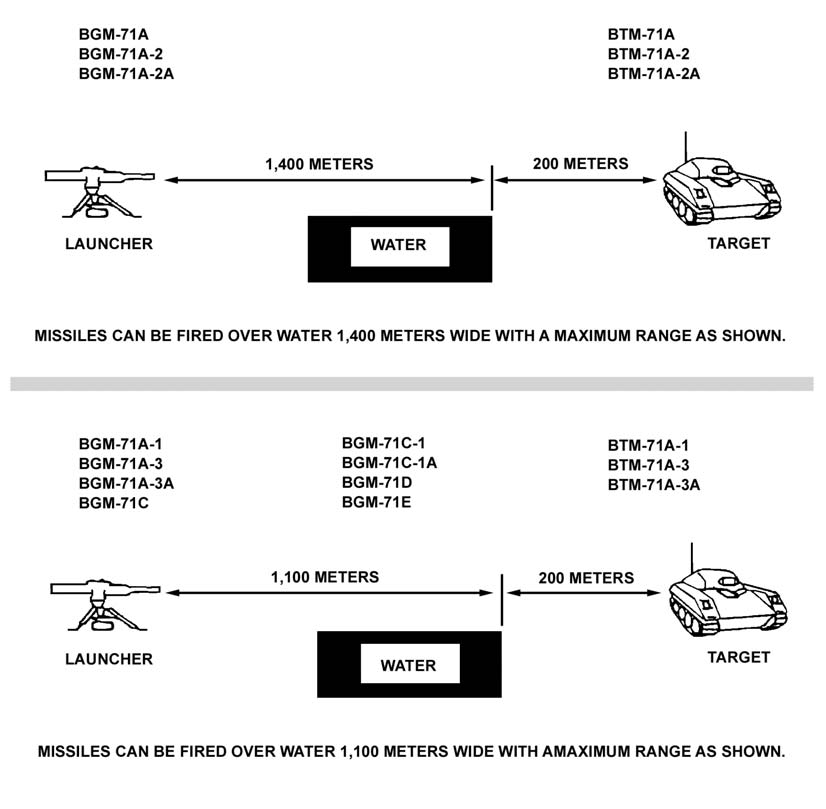
FM 3-22.34
(2) The various types of TOWs listed may be fired over water to a limited range as shown in Figure 2-2 (TOW launcher and target at water surface level).
(3) To determine the extended range of missiles when firing over water (when TOW
launcher or target is above surface level of water), use Table 2-1 (pages 2-6 and 2-7).
(a) Determine the type of missile being used.
(b) Determine the height above the water surface of the TOW launcher and place a tick mark at the corresponding height in the left-hand column of the table.
(c) Determine the height above the water surface of the target. Place a tick mark at the corresponding height in the right-hand column of the table.
(d) Connect the two tick marks with a straight line. The point where the lines intersect the center column is the maximum range the missile can travel without getting too close to the water.
Figure 2-2. Limited TOW missile range.
2-5
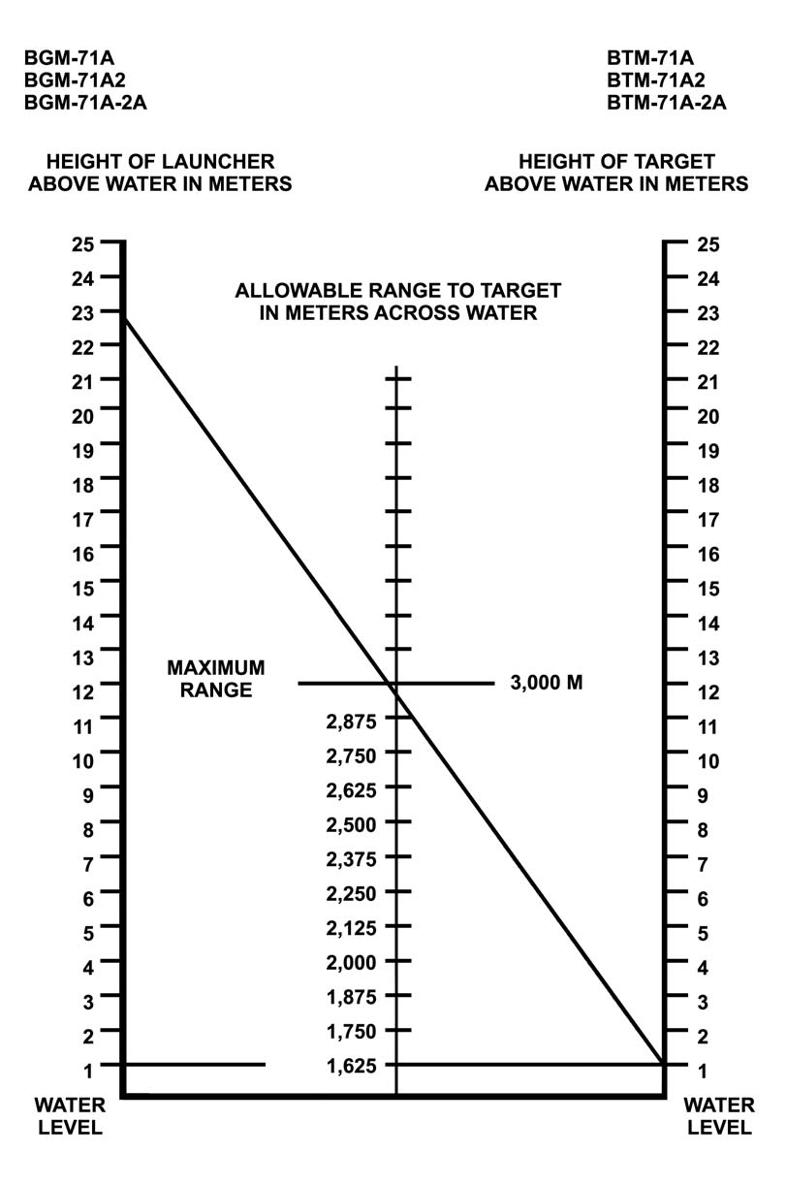
FM 3-22.34
Table 2-1. Extended range over water.
2-6
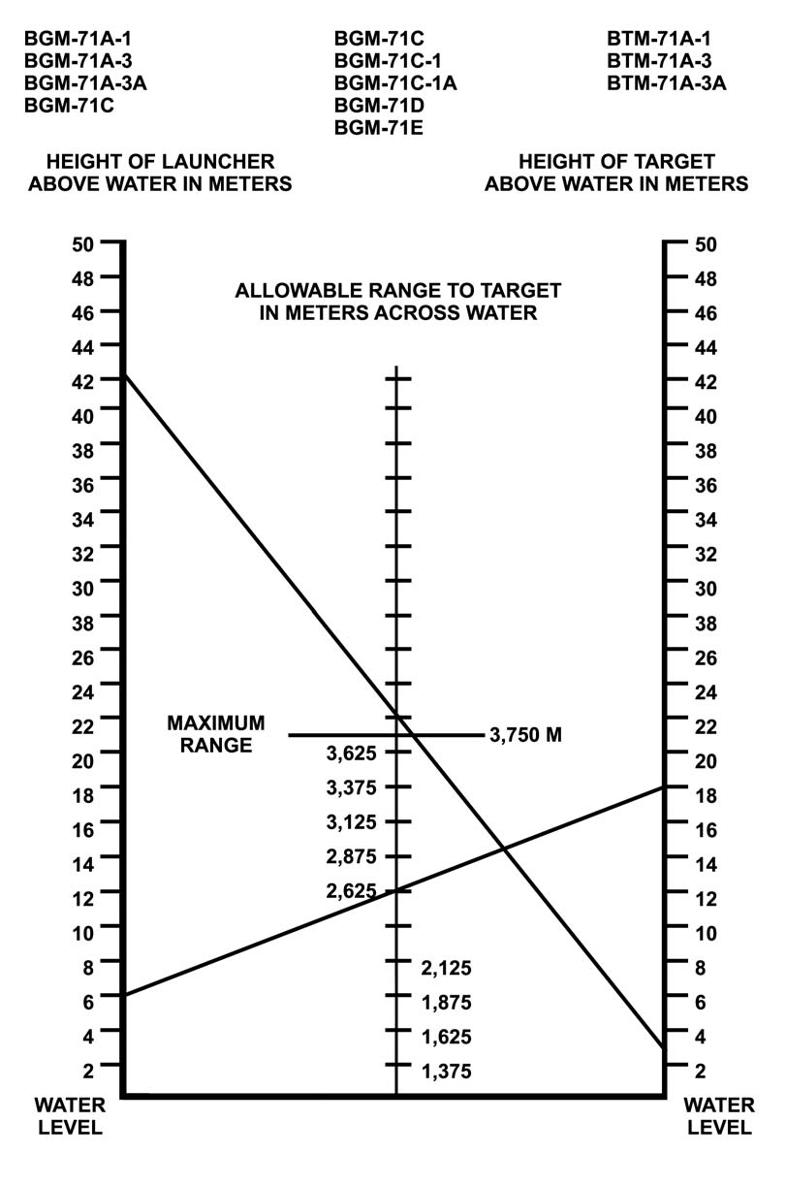
FM 3-22.34
Table 2-1. Extended range over water (continued).
2-7
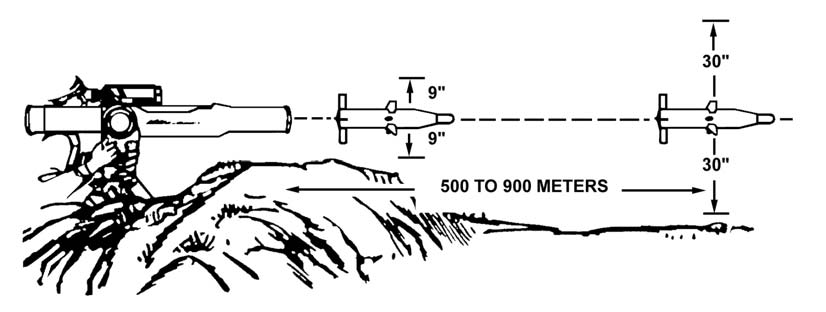
FM 3-22.34
b.
Firing Over Electrical Lines. If the command-link wires contact a live high-voltage power line, personnel can be injured or control of the missile can be lost.
The launcher electronics may also be damaged. In addition to power lines, other high-voltage sources include street cars, electric train ways, and some moving target trolleys on training ranges.
c.
Firing in Windy Conditions. Gusty, flanking, or quartering winds can cause the launch tube to vibrate and spoil the tracking performance. The effect is similar to driving in a strong crosswind. Erecting a windscreen next to the launcher helps to reduce this problem. Strong winds can move the missile around during flight, but as long as the crosshairs are kept on the center mass of the target, the weapon system itself can compensate for wind effects.
d.
Firing Through Smoke and Area Fires. Smoke can obscure the line of sight and hide the target when using the daysight tracker. A smooth tracking rate should be maintained as the target disappears into a smoke cloud so that the missile will still be on target or very close as the vehicle goes out the other side of the smoke cloud. (This technique should be practiced during field tracking exercises.) A fire can burn through the command-link wire, causing loss of control of the missile. The gunner should avoid firing through fire and over fires if there is a possibility that the wires will contact the fire before missile impact.
e.
Firing from Bunkers and Buildings. In accordance with DA Pam 385-63, TOWs will not be fired from buildings, bunkers, or within 100 meters of a vertical or nearly vertical backstop without the approval of the commanding general. (See Appendix E for further safety precautions.)
f.
Clearance Requirements. The TOW muzzle must have at least nine inches of clearance at the end of the launch tube so the wings and control surfaces of the missile will not be damaged when they extend after clearing the launch tube. The muzzle of the launch tube must extend beyond any enclosure, window sill, or aperture, and at least 30
inches of clearance must be between the line of sight and any obstruction from 500 to 900
meters downrange. A 30-inch line-of-sight clearance ensures a high probability the missile will not strike the ground on the way to the target (Figure 2-3).
Figure 2-3. Clearance requirements.
2-8
FM 3-22.34
2-7.
DESTRUCTION OF TOW WEAPON SYSTEMS
When subject to capture in the combat zone, the encased missile and weapon system and its components are destroyed by the TOW squad. This action is taken when, in the judgment of the unit commander, the tactical situation warrants it, and when it is necessary IAW orders or policy established by the commander.
NOTE:
The following information is for guidance only. Certain procedures outlined require the use of explosives and incendiary grenades that may not be authorized items for the TOW squad. The issue of these and related materials and the conditions for destruction are command decisions.
Destruction of TOW components by mechanical means, explosives, gunfire, or burning renders them useless to the enemy. The best method to destroy everything is to set fire to the carrier. To prevent the enemy from obtaining useful equipment, the encased missiles and certain weapon system parts should be destroyed. When lack of time or personnel prevents destruction of all parts, the encased missiles and the priority parts of each weapon system must be destroyed. Destroying the same parts of each weapon system prevents the enemy from assembling a complete weapon system. Priority is used to select the parts for destruction. If destruction is directed, the TOW squad selects a point of destruction that will cause the greatest obstruction to enemy movement and not create a hazard to friendly troops.
Each organization and installation that uses, maintains, or stores the encased missiles or weapon system parts should have an SOP for TOW destruction. The procedure should contain priorities of destruction, methods of destruction, quantities of explosives required, and instructions for destruction. The destruction plan should be flexible to cover any situation.
a.
Destruction of Encased Missiles. The encased missile is a priority item and should be destroyed by any of the following methods. The expended launch containers should also be destroyed or removed from the battlefield so that enemy troops may not use them to make improvised munitions and booby traps.
WARNING
Do not attempt to destroy encased missiles by
mechanical methods.
(1)
Launch the Missiles. If the system is operational and time permits, launch the missiles into enemy territory before destroying the vehicle. Missile detonation should hinder the enemy in every way possible without endangering friendly units or equipment.
(2)
Use Explosives. To destroy the TOW using explosives, become familiar with the provisions of FM 5-250.
(a) Using three pounds of TNT or equivalent, prepare and place a 1-pound explosive charge 6 to 8 inches from the nose end, a 1-pound explosive charge 4 to 6 inches behind the electrical connector, and a 1-pound explosive charge 6 to 8 inches from the motor end of the missile (Figure 2-4, page 2-10).
2-9
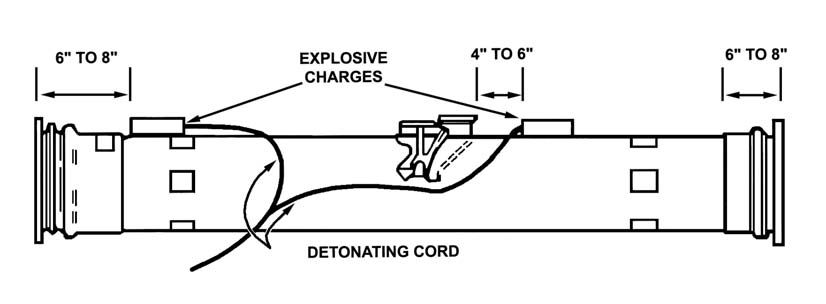
FM 3-22.34
NOTE:
Because the missile contains high explosive, a smaller explosive charge may be used to destroy it.
Figure 2-4. Explosive charges on an encased missile.
(b) Determine if electrical blasting caps and wire or nonelectric blasting caps and safety fuses will be used for priming and detonating the explosive charges. If nonelectric caps are used, crimp them to a safety fuse at least 2 meters long.
WARNING
Safety fuse burns at the rate of 1 foot in 30 to 40
seconds. Safety fuse, which contains black
powder, and blasting caps must be protected
from moisture at all times.
(c) Connect the charges with detonating cord to produce a simultaneous detonation.
Dual prime the charges to reduce the possibility of a misfire.
WARNING
The blasting caps, detonating cord, and safety
fuses must be kept separate from the charges
until needed.
(d) If the charges are primed with nonelectric blasting caps, ignite the safety fuses and take cover at once. If the charges are primed with electric blasting caps, take cover before firing.
(3)
Use Gunfire. Use well-aimed shots from artillery, rockets, rifle grenades, or tank guns to destroy the encased missile by gunfire.
2-10
FM 3-22.34
WARNING
The live rocket motors and high-explosive
antitank warhead are a hazard to soldiers firing at
the encased missile. Therefore, small arms should
not be used. Firing artillery from ranges of 1,000
meters or less must be done from cover. Cover
must also be used when rifle grenades or rockets
are fired.
b.
Destruction of Weapon Systems. Destruction of TOW parts should be done so that the use or restoration to serviceable condition is impossible. In addition, certain weapon system parts could provide important information to the enemy.
(1)
Priority of Destruction. If time does not permit the destruction of the complete weapon system, destroy as many parts as possible in the following priority:
• Daysight tracker.
• Nightsight.
• Missile guidance set.
• Traversing unit.
• Battery assembly.
• Launch tube.
• Tripod.
• Battery power conditioner (TOW 2).
(2)
Destruction Methods. Consider the location of friendly units and the availability of personnel, materials, and time required for destruction when selecting the method of destroying TOW parts. The following list of destruction methods is in priority sequence; however, the considerations stated above could change the priority or method of destruction used.
(a)
Explosives. Use at least one pound of explosive on each









